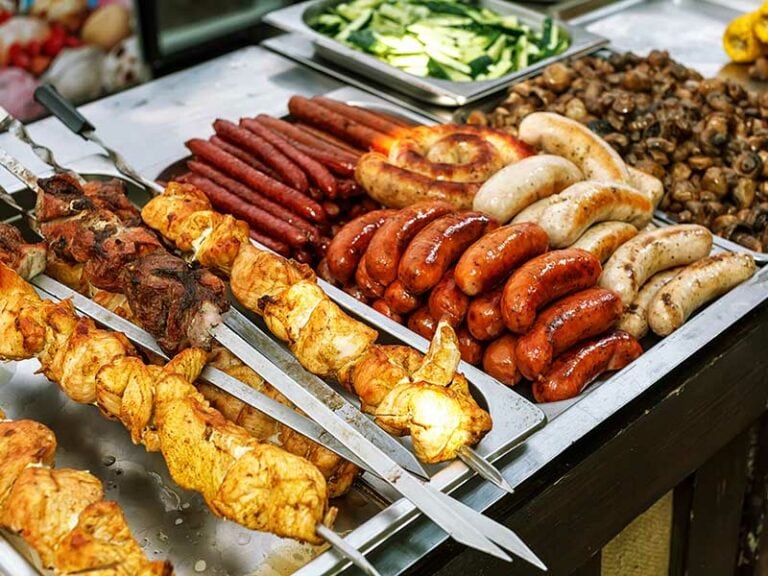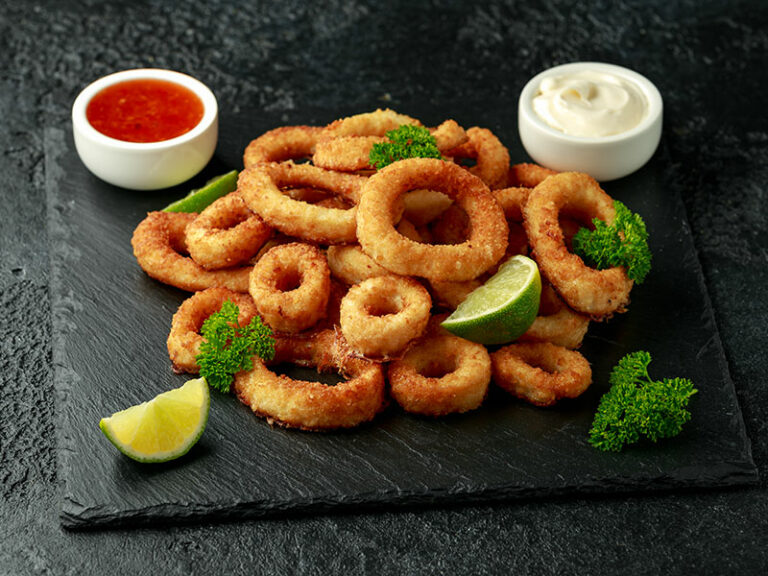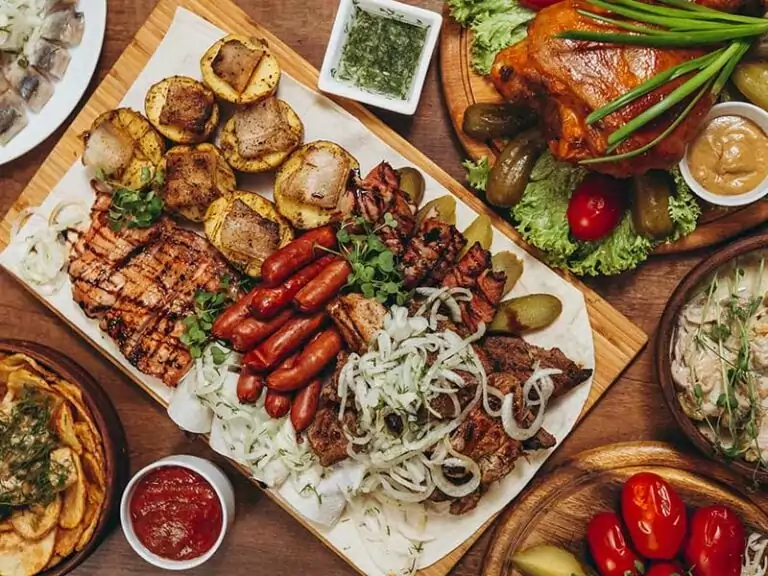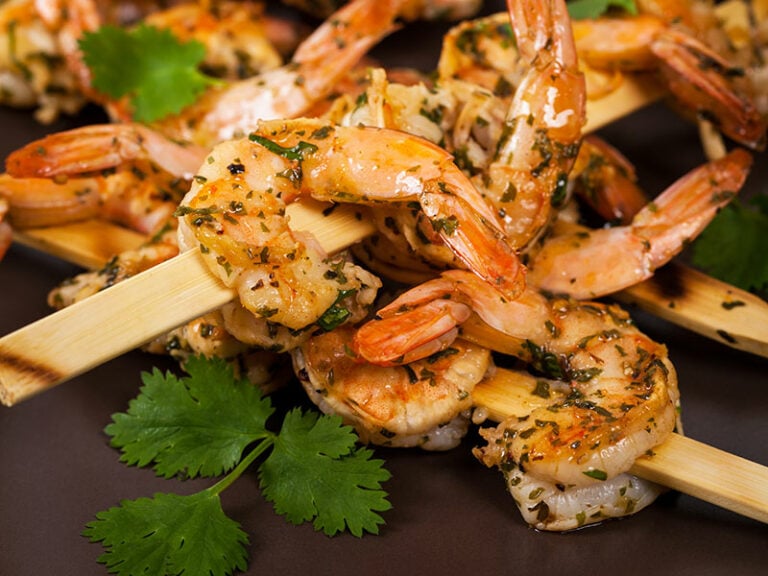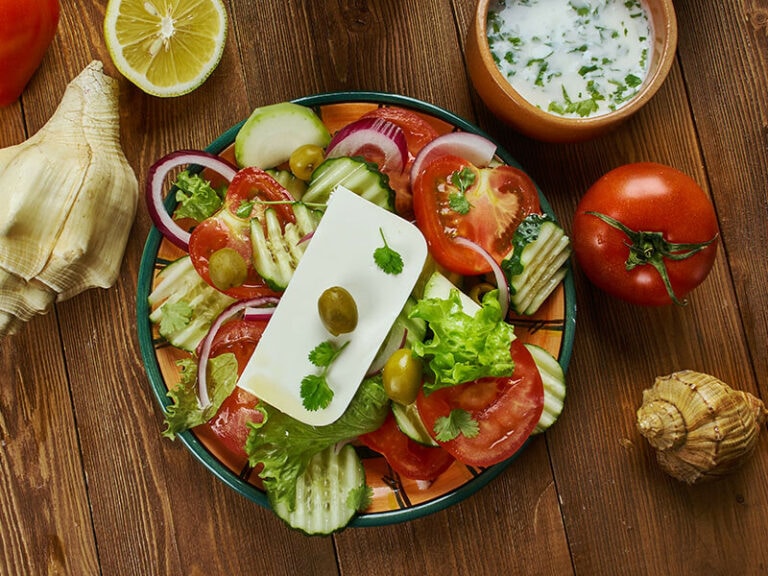European cuisine history is rich and flavorful, like many dishes it has created. In this topic, you’ll discover the stories, influences, and cultural exchanges behind this well-known cuisine.
I’ll guide you through these chronicles, where you’ll gain insights into the food evolution and several historical events influencing the traditional European culinary scene. When you understand the history of European cuisine, you’ll appreciate every bite even more.
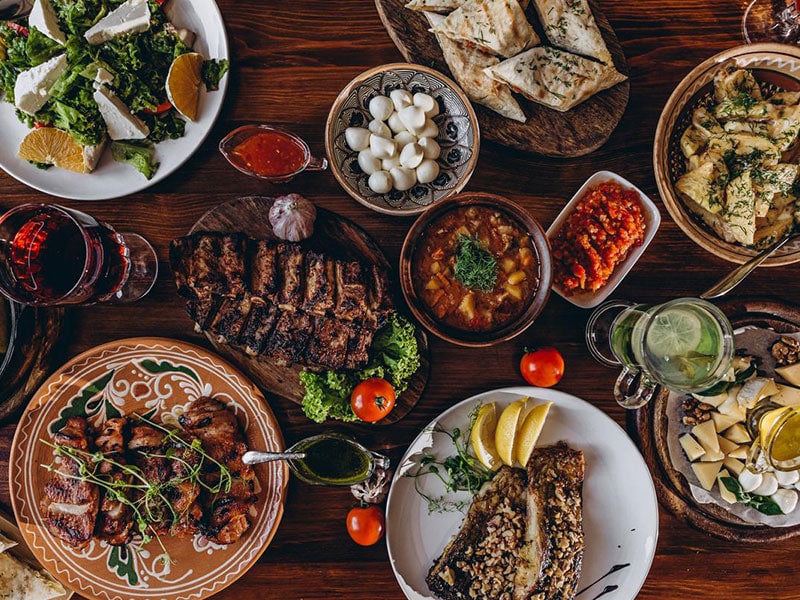
Key Takeaways
Overview Of European Cuisine
Welcome to the world of European cuisine, a diverse and historical culinary landscape that’s as varied as the continent itself. In this part, you’ll learn about its definition and historical background.
Definition
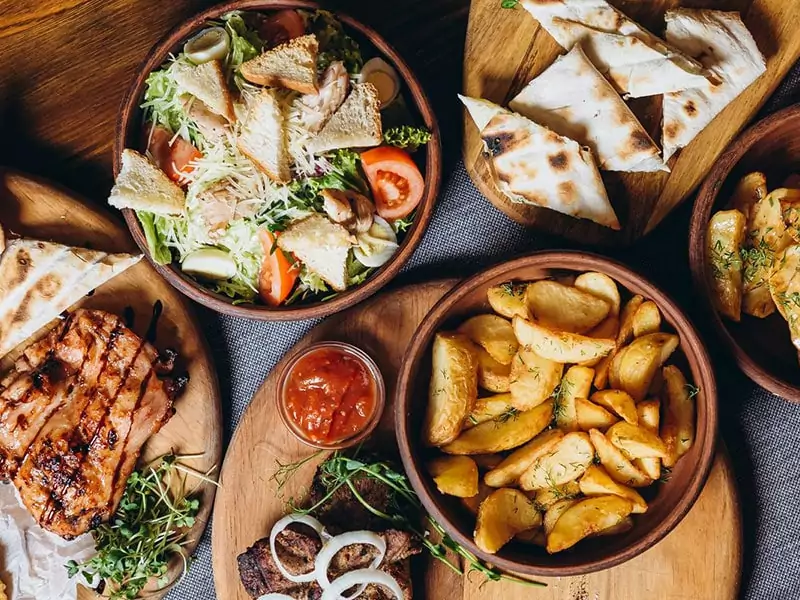
European cuisine, often called “Western cuisine,” is a collective term referring to European cooking traditions. It includes the culinary arts of different nations such as France, Italy, Germany, Spain, the United Kingdom, etc.
They are all diverse, reflecting these countries’ unique culture, history, and geography. European cuisine is also characterized by its broad range of ingredients, cooking methods, and traditions.
European cuisine significantly affects global gastronomy, with numerous dishes recognized worldwide. They include Italian pasta and pizza, French baguette and croissants, Spanish tapas and paella, British fish and chips, German sausages and beer, to name a few.
While these dishes represent their birthplace, they are now enjoyed globally, testifying to the popularity and influence of European cuisine.
General Historical Background
European cuisine’s history is complex and varied. Countless influences have influenced it for thousands of years, from geographical aspects to cultural exchanges, invasions, and innovations. People, migration, trade, and the development of society have painted a vibrant picture of the European past.
European cuisine evolved when the Romans and Greeks made some foundational elements. Since then, various socio-political and economic changes have impacted what, how, and why Europeans eat today.
In The Antiquity Time (Pre-5th century)
Let’s step back in time, as you dive into the antique roots of European gastronomy. The ancient Greeks and Romans, the formidable Vikings, and the mystical Celts each left a distinct culinary imprint that has shaped European cuisine over the centuries.
Greek and Roman

Greek cuisine is one of the earliest cornerstones of European culinary tradition. Rooted in the Mediterranean, ancient Greeks adopted the ‘Mediterranean triad’ in their diet, consisting of olives, grains (barley and wheat), and grapes.
These ingredients were commonly used in breadmaking, oil pressing, and wine production. Although simple, Greek meals were balanced and nutritious, often accompanied by cheese, fruits, and legumes.
On the other hand, Roman cuisine developed significantly over time. Early Roman food was influenced heavily by Greek ones. But as the Roman Empire expanded, so did its culinary repertoire.
Roman cuisine appears in various texts, like Apicius’s De Re Coquinaria, providing insight into their diet and food preparation methods. The Romans enjoyed various foods, including meats, fish, fruits, and vegetables, with different sauces and spices.
They also introduced more complex cooking methods and dining customs, later influencing Medieval and Renaissance European cuisines.
Norse/Viking
The Norse or Viking cuisine was mostly dictated by the harsh climate of Scandinavia and the Vikings’ seafaring lifestyle. Their diet was high in protein and fat, sourced from sea and land animals, fish, and dairy products.
Grains were used for bread and porridge, while fruits and vegetables were limited due to the climate. Preservation techniques like salting, smoking, and pickling were common. Norse cuisine has a lasting influence on Scandinavian culinary traditions even today.
Celtic
The Celts spread across a vast region, including Ireland, Scotland, Wales, and parts of mainland Europe. Their diet depends on their local products. They farmed grains for bread and porridge, reared cattle for dairy, meat, and leather, and gathered fruits, nuts, and wild plants.
The Celts were also skilled in fermentation, producing beer and mead. While they did not leave written recipes, archaeological findings and historical texts explain their dietary habits. This cuisine has influenced the British Isles and Brittany in France.
In The Middle Ages (5th To 15th Century)
Step with me into the Middle Ages, a pivotal era in the story of European gastronomy. Divided into early and late periods, this period was a time of culinary innovation and exploration.
Early Medieval Cuisine
Early medieval cuisine was under the strong influence of Christianity and the feudal system, both leaving a distinct imprint on the food traditions of the era. These two intertwined threads wove a complex tapestry of early European gastronomy.
Impact of Christianity
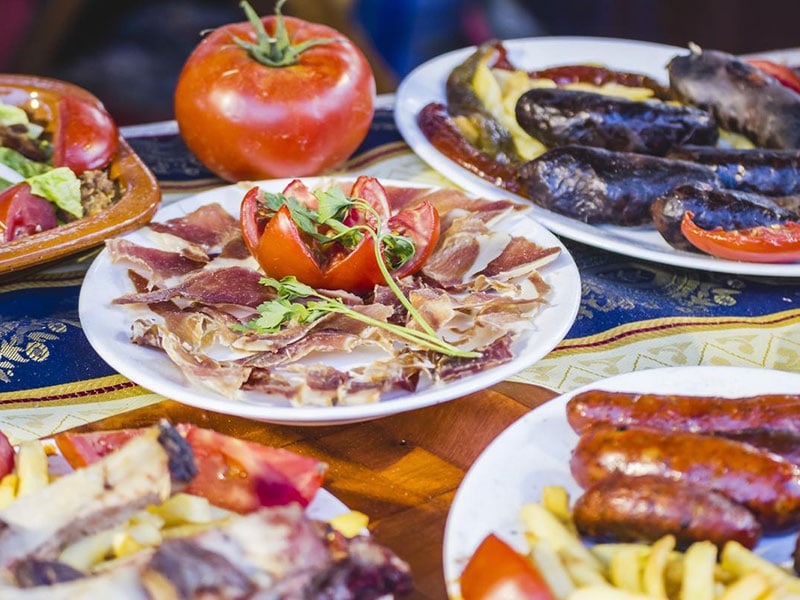
Based on a study in St. Albans secondary college, Christianity was the dominant religion in Europe during the Middle Ages, thus having a profound impact on culinary culture.
Church-prescribed fast days make people search for meat substitutes, leading to increased fish consumption and the development of numerous vegetable and grain dishes.
Monastic communities were influential in advancing agricultural practices, and many monasteries had their own gardens, vineyards, and fishponds to ensure a varied diet.
Feudal System’s Influence
The feudal system also shaped food consumption. Those at the top, including nobility and higher clergy, had access to countless foods: quality meats, imported spices, and fine wines. Meanwhile, the lower classes only consumed simpler fare, often relying on grains and vegetables, with limited access to meat.
Late Medieval Cuisine
In the late medieval cuisine era, international trade blossomed, introducing Europe to new flavors. At the same time, the Crusades drew the continent’s culinary curiosity towards the East, blending unexpected ingredients into their cooking.
Development Of International Trade
As trade developed in the late Middle Ages, European cuisine also diversified. Spices from the East, such as black pepper, cinnamon, and cloves, arrived in Europe via trade routes, enhancing foods’ flavor here. The wealthy class also used these spices as a display of their affluence.
Influence Of the Crusades
The Crusades (11th to 15th centuries) exposed Europeans to Middle Eastern cuisines, resulting in new cooking methods, ingredients, and dishes. The returning crusaders brought rice, lemons, and aubergines, which started appearing in European meals.
This period also saw a distinct shift towards more complex dishes. People focused more on presentation, with meals designed to impress guests, especially among the upper class. This tradition was the foundation for the great culinary traditions in the Renaissance era.
Through The Renaissance And Early Modern Period (15th To 18th Century)
The Age of Discovery proved to be a transformative time for European cuisine, particularly in Italy and France, whose culinary prowess took center stage. With new worlds uncovered, the spice trade flourished and forever changed the continent’s gastronomic landscape.
Influence Of The Age Of Discovery
The Age of Discovery, beginning in the late 15th century, dramatically transformed European cuisine. As explorers ventured into Asia, Africa, and the Americas, they brought back various new foods, redefining European dining.
Maize, potatoes, tomatoes, chili peppers, vanilla, cacao, and other foods were introduced to Europe during this period. Initially met with skepticism, these foods eventually became popular. For example, potatoes became a staple in Northern Europe, while tomatoes were well-loved in Italy.
French And Italian Culinary Dominance
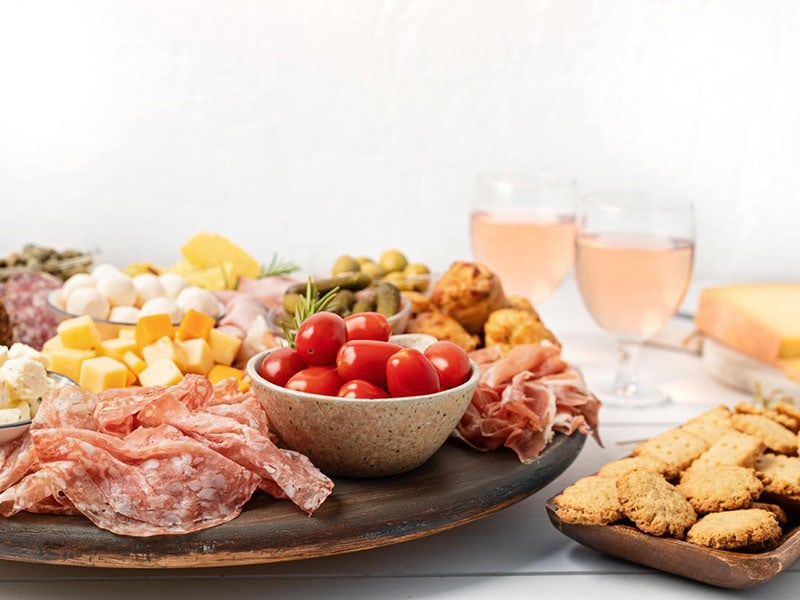
This period also saw the rise of France and Italy as culinary leaders in Europe. French cuisine began to take its modern shape during the Renaissance, focusing on quality ingredients, artistic presentation, and lighter dishes.
Notable chefs, like François Pierre La Varenne, and later Marie-Antoine Carême and Auguste Escoffier, developed many cooking techniques for French cuisine. And Catherine de Medici, a Florentine family member and later queen of France, is often credited with bringing Italian culinary practices to France.
Meanwhile, Italian regional cuisines became more diverse. For example, the North focused on hearty meat and dairy-rich dishes, and olive oil, tomato, and seafood dishes are the backbones of the South.
The Spice Trade
The spice trade continued to impact European cuisine, though it experienced some changes during this period. With new maritime routes, imported spices became less expensive and more accessible. This allowed more people to enjoy flavorful food, enriching European cuisine.
In The Industrial Revolution (18th To 19th Century)
The Industrial Revolution did more than just restructure society. Innovations in cooking methods and kitchen tools, alongside a change in food preservation and distribution, opened doors to a new world of gastronomy.
From this evolution, the concept of restaurants emerged, paving the way for the birth of haute cuisine.
New Cooking Methods And Kitchen Tools
The Industrial Revolution significantly changed European cuisine through new cooking methods and kitchen tools. The invention of the cast iron stove allowed precise control of temperatures, enabling more complex dishes.
Other kitchen tools, such as the mechanical egg beater and pressure cooker, made cooking more efficient and streamlined.
Changes In Food Preservation And Distribution
New methods of food preservation, like canning and refrigeration, transformed how Europeans stored and consumed food. With long-lasting canned goods, people could enjoy various foods all year round. Refrigeration also improved food safety and fresh products even in off-season periods.
The development of railways and improved road networks facilitated food distribution across greater distances. As a result, regional cuisines could reach more people and contain other ingredients not native.
Birth Of Restaurants And Haute Cuisine
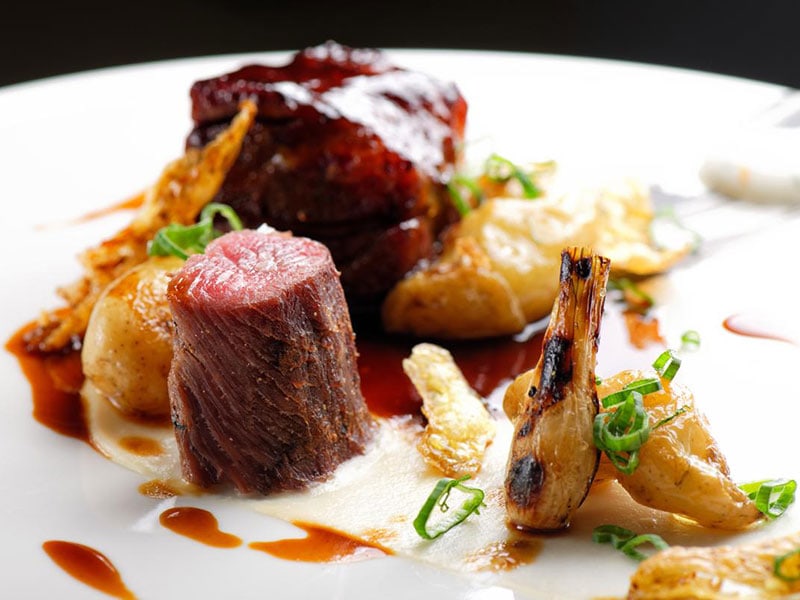
During this period, taverns and inns developed into modern restaurants, thus a more varied menu and refined dining experience. Along with it, haute cuisine appeared in France, a cooking style emphasizing high-quality ingredients, intricate preparation, and elaborate presentation. This concept became a hallmark of French cuisine and other restaurant cultures worldwide.
In The 20th Century
The 20th century opened a transformative era for European cuisine, marked by two World Wars. Post-war changes led to a swift modernization of the food industry. Amidst this shift, the age of convenience foods dawned, culminating in the culture of fast food today.
Influence Of Two World Wars
There is no argument about the two World Wars profound impact on European cuisine. Food shortages significantly affected diet and cooking practices. Due to limited resources, people were forced to invent new dishes and preparation methods.
The wars also prompted advances in food technology for military use, such as freeze-drying and pre-packaging. These technologies are later adopted in civilian life.
Post-War Changes And Modernization Of The Food Industry
After the wars were an increased pace of change in the food industry. Thanks to the birth of modern supermarkets, frozen food, and microwave ovens, convenience and speed became important aspects of cooking and eating.
This led to the development of ready meals and fast food, which became increasingly popular, particularly in the latter half of the 20th century.
The Emergence Of Convenience Foods And Fast Food Culture
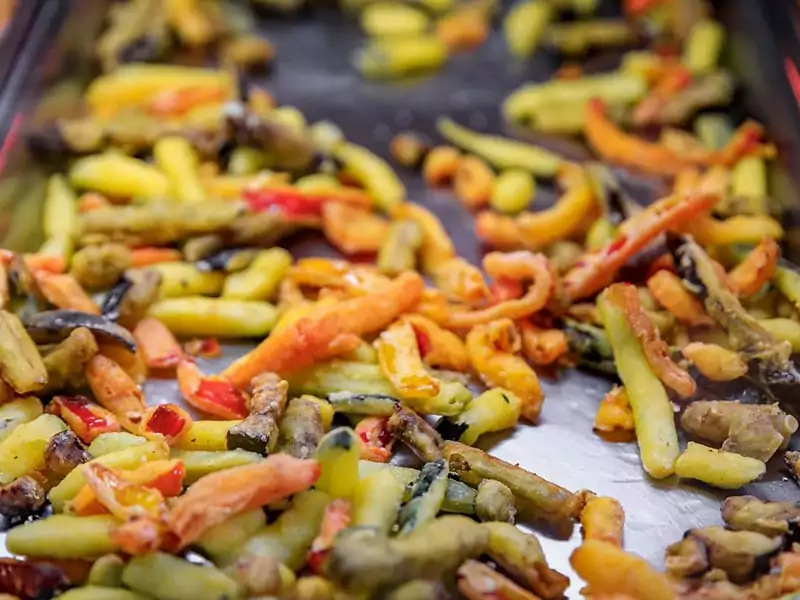
Convenience foods and fast food culture continued to develop in the 20th century. These changes were influenced by urbanization, increased women’s participation in the workforce, and improved living standards.
Companies like McDonald’s expanded rapidly across Europe, influencing dietary habits. At the same time, convenience foods led to the wide availability of products like instant coffee, pre-packaged meals, and snack foods.
While these changes offered convenience and saved time, they raised concerns about health and nutrition. Many debates about food quality and safety have continued to this day.
21st Century And Beyond
Today’s European cuisine is a vibrant combination of new trends, influenced by food media and technology. In the future, these influences will continue to shape European cuisine, promising an exciting and unpredictable journey.
Current Trends
European cuisine in the 21st century is characterized by countless traditional dishes, modern innovations, and influences worldwide. Here are several nowadays trends:
- Farm-to-table movement: This style emphasizes fresh, locally sourced ingredients. It promotes sustainability and supports local farmers and producers.
- Fusion cuisine: This involves combining different culinary traditions. European cuisine has been fused with various global cuisines, creating exciting and innovative dishes.
- Gourmet fast food: This trend reimagines fast food with a gourmet twist, focusing on quality ingredients and inventive flavors while maintaining convenience.
- Plant-based and vegetarian diets: These two diets have become more popular with increasing awareness about health and sustainability. Many European restaurants now offer vegetarian, vegan, and plant-based meats.
Influence Of Food Media And Technology
The Internet, social media, and cooking shows have made food more accessible. People can now share recipes and culinary experiences online, and food delivery apps have made diverse cuisines readily available.
Furthermore, technology has been part of food preparation and distribution. Innovations such as sous-vide cooking, molecular gastronomy, and 3D printing redefine European cuisine.
Looking Forward
In the future, European cuisine will continue to evolve, shaped by different factors: sustainability concerns, global influences, and culinary innovation. It will continue to be an exciting reflection of the continent’s history, culture, and aspirations.
Influences On European Cuisine
European cuisine’s unique flair arises from the region’s geography and agriculture. Beyond the borders, trade routes and cultural exchanges further reshape European dining tables.
Geography And Agriculture
Geography has been a vital part of European cuisine. Europe is a large continent with various climates, terrains, and resources, creating different regional cuisine.
Countries like France and Ukraine have fertile plains conducive to agriculture, particularly grains like wheat, thus a bread-centric culture. The Mediterranean region has a warm climate, ideal for growing olives, grapes, fruits, vegetables, and herbs, leading to a rich diet.
On the other hand, Spain, Portugal, and Norway have many seas, rivers, and coastlines. This fact has shaped a strong fishing tradition in these nations.
Trade Routes
Trade routes come in both forms, overland and maritime. As mentioned above, spices coming through the Silk Road have added flavor to various European dishes.
And European explorers in the Age of Discovery established sea routes to the Americas, Asia, and Africa to import countless new ingredients. For instance, the Columbian Exchange brought potatoes, tomatoes, maize, beans, and peppers to Europe.
Cultural Exchanges With Other Regions
Europe’s cuisine has also experienced many cultural exchanges with other regions. The interaction between Europe and the Middle East during the Crusades brought many new culinary ideas. For instance, the Moorish invasion introduced North African cuisine elements to Spain.
Moreover, European colonialism led to a two-way exchange of food habits between Europe and its colonies. While the Europeans introduced their cooking methods and ingredients to the colonized lands, they also brought back exotic ingredients and dishes.
Regional Highlights Of European Cuisine
From the hearty fare of Northern Europe to the vibrant flavors of the South, the gastronomic map of Europe presents a banquet of culinary diversity. As you journey through Western and Eastern Europe, you’ll find the compelling regional essence of European cuisine.
Western Europe
In European culinary scene, Western Europe contains many traditional dishes. With French elegance and Italian passion for simple, high-quality ingredients, this region is a fusion of sophistication and earthy charm, stirring the pot of culinary innovation.
French
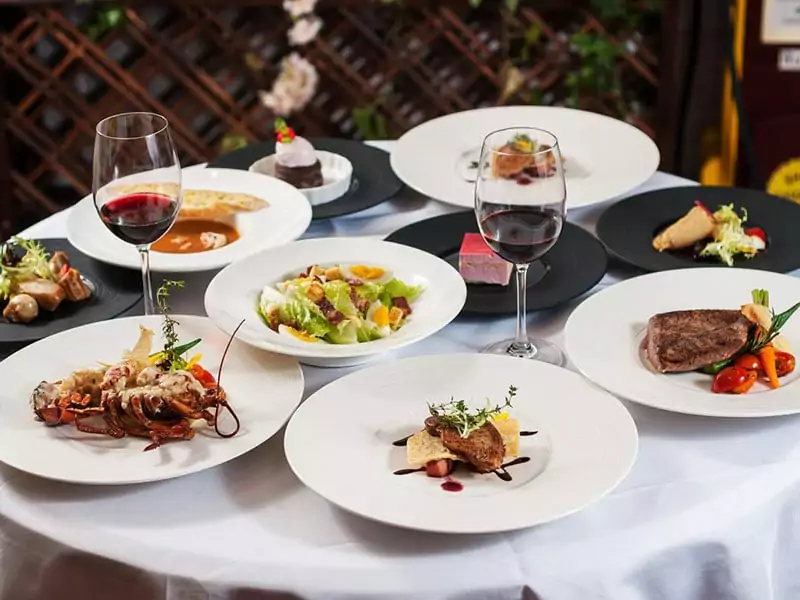
Renowned for its finesse and flavor, French cuisine offers various regional cuisines, from the rich, creamy Normandy dishes to the hearty Alsace stews. French haute cuisine, emphasizing complex preparation and elegant presentation, has greatly influenced global culinary arts.
Italy
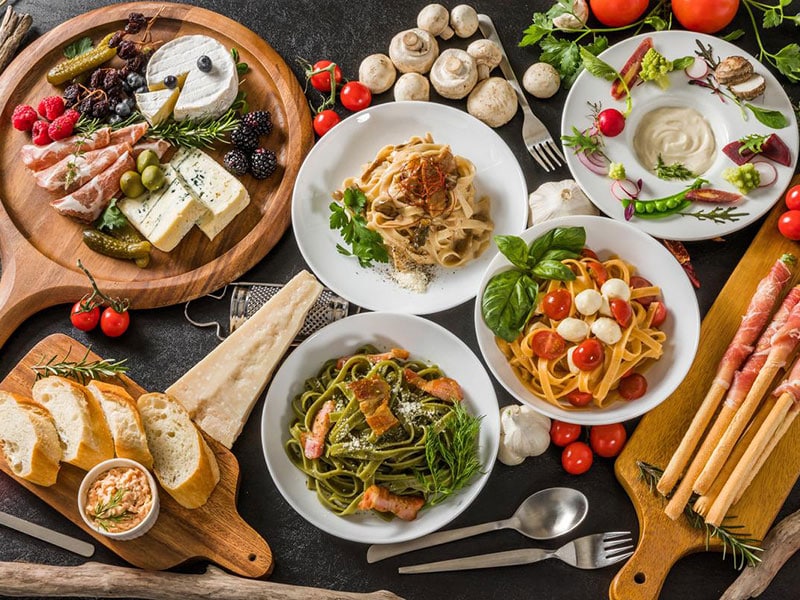
Italian cuisine is diverse and flavorful, with pasta and tomato-based dishes in the South and meat and dairy-rich diets in the North. Signature Italian dishes like pasta, pizza, risotto, and gelato are loved worldwide.
Northern Europe
When you glance at classic Northern European delicacies, the Scandinavian cuisine poses a distinctive allure. From seafood to meat dishes, the region expresses its authentic culinary narrative, accentuated by the simplicity of ingredients and a deep respect for nature’s bounties.
Scandinavia

Scandinavian cuisine, including Norwegian, Swedish, Danish, and Finnish, incorporates seafood, particularly herring, and preserved foods. The modern culinary movement, known as New Nordic, focuses on local, seasonal ingredients, emphasizing purity, simplicity, and freshness.
Eastern Europe
With Russia and Poland as its culinary flag bearers, Eastern European cuisine offers a journey through robust, soul-warming dishes. They represent a blend of tradition and rustic charm, reflecting the resilience and creativity of these cultures.
Russia
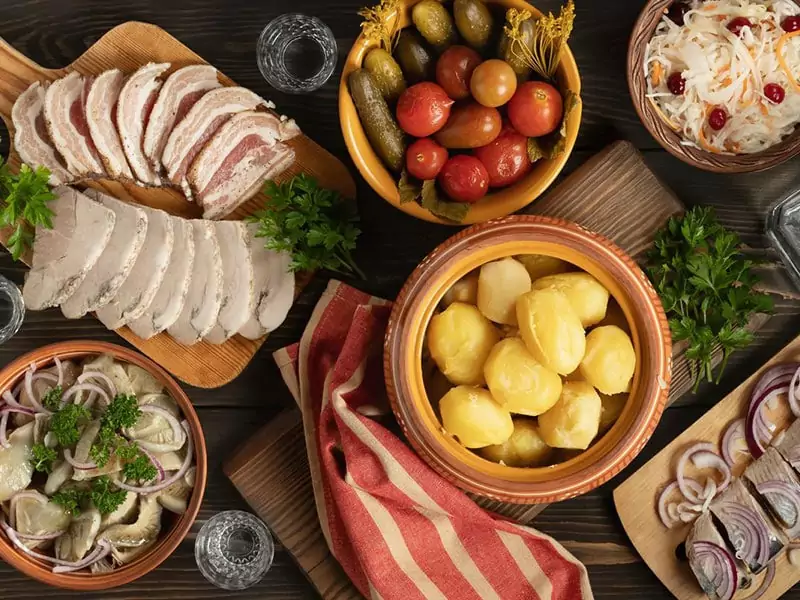
Russian cuisine is known for its hearty, filling dishes. Staples include Borscht (beetroot soup), Pelmeni (meat-filled dumplings), and Blini (thin pancakes), alongside many fermented foods and drinks.
Poland
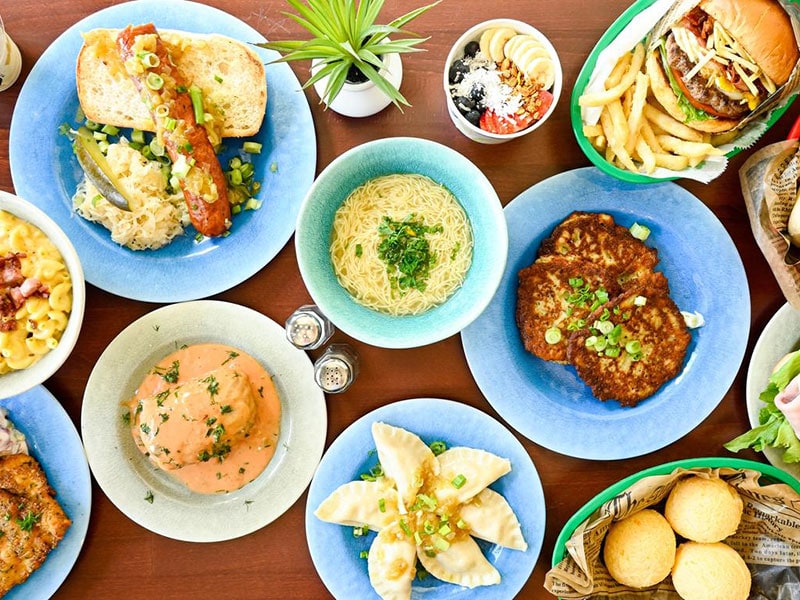
Polish cuisine is rich in meat, particularly chicken, pork, and beef, besides numerous winter vegetables and herbs. Pierogi, a type of stuffed dumpling, is a traditional and popular Polish dish.
Southern Europe
In the realm of traditional Southern European cuisine, especially Spain and Greece, you’ll see a vibrant and diverse culinary narrative. These countries is where every meal narrates a tale of age-old traditions, abundant harvests, and an uncompromising passion for flavor.
Spain
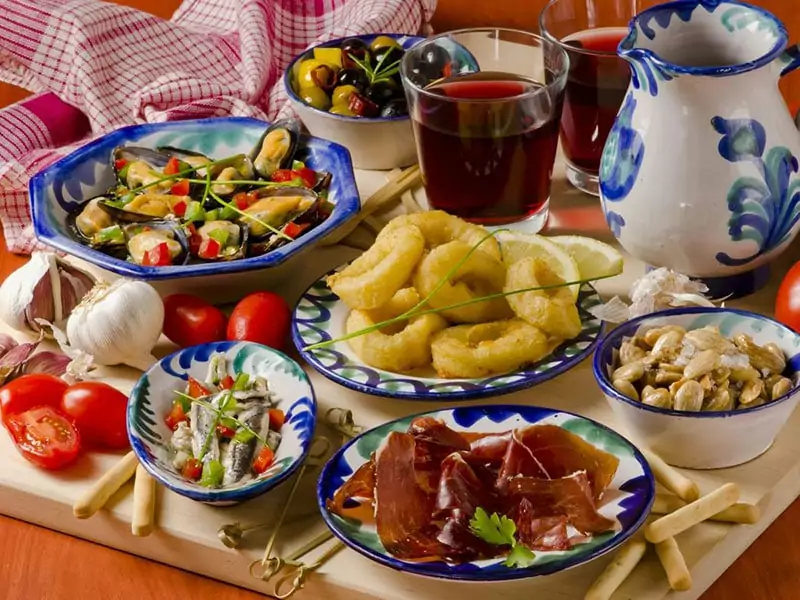
Spanish cuisine features abundant fresh seafood, cured meats like the famous Jamón ibérico, and unique regional dishes. Tapas, small dishes enjoyed socially, are a fundamental part of Spanish food culture.
Greece
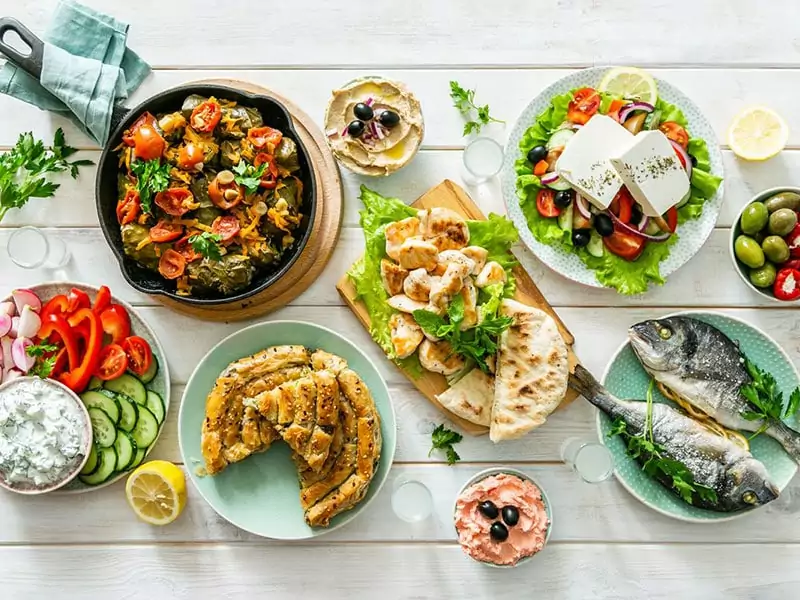
Greek cuisine is part of the Mediterranean diet, utilizing ingredients like olive oil, fish, cheese, yogurt, fruits, and vegetables. Classic Greek dishes include Moussaka, Souvlaki, and Tzatziki.
Influence Of European Cuisine On The World
European cuisine’s influence spans the globe, profoundly shaping culinary education and careers worldwide. European dining has revolutionized the world’s culinary scene, while its wine and spirits expertise has enlivened global beverages.
Additionally, European cuisine has left an indelible mark on global gastronomy.
Global Spread
European dishes and ingredients have entered all corners of the globe. Ingredients like potatoes, tomatoes, peppers, and corn, have become staples in many non-European cuisines. They transformed the cuisines of other regions and had significant socio-economic impacts.
Influence On Wine And Spirits
European touch is also notable in the production of wine and spirits. France, Italy, and Spain are among the largest wine producers and have deeply influenced winemaking techniques worldwide. Likewise, spirits like Scotch whisky, Irish whiskey, French cognac, and Russian vodka are globally recognized.
Dining Experience
The European dining experience has been exported globally. The French dining style and service, the family-oriented and course-based Italian meals, the tapas tradition in Spain, and the pub culture of the UK have influenced many parts of the world.
Influence On Culinary Education And Profession
European influence even extends to culinary education and the cooking profession. French cooking techniques form the basis of professional education in many countries.
The concept of celebrity chefs like Auguste Escoffier, Marco Pierre White, and Gordon Ramsay has also influenced the global perception of cooking as a profession.
Future Directions And Challenges
European cuisine is poised for a future laden with exciting challenges and directions. Sustainability and ethical considerations redraw the culinary map.
Simultaneously, health, nutrition issues and food technology innovations, coupled with globalization migration, and climate also make changes in the historic gastronomy.
Sustainability And Ethical Considerations
Looking to the 21st century, sustainability and ethical considerations increasingly influence European cuisine. Consumers are more aware of the environmental effect of their foods, leading to organic farming, sustainable fishing, and food waste reduction.
Awareness of the ethical implications of food production also grows, hence a rise in vegetarianism, veganism, and the humane treatment of animals.
Health And Nutrition
European cuisine emphasizes health and nutrition more. The Mediterranean diet, which focuses on fruits, vegetables, whole grains, and olive oil, has gained popularity for its health benefits. At the same time, people demand reduced sugar, salt, and processed foods.
Innovation In Food Technology
Advances in food science have led to techniques like molecular gastronomy, merging science with culinary art. In addition, technologies like 3D food printing, lab-grown meat, and AI in food preparation and service will revolutionize the European culinary scene.
Impact Of Globalization And Migration
Globalization and migration will continue introducing new flavors and dishes to European cuisine. Europe’s multicultural societies contribute to numerous food experiences, with fusion cuisine combining traditional European flavors with global influences.
Climate Change
Climate change is a significant challenge to European cuisine. Temperature changes and precipitation patterns can affect crop production of certain ingredients, forcing changes in dietary habits and culinary practices.
FAQs
Do You Love This History Trip?
From quaint French patisseries to hearty German feasts, the history of European cuisine is a vivid tapestry of diverse cultures. Each dish carries a story, each flavor a memory. As I go through these culinary delights, I feel like I’m tasting the past.
I hope you’ve enjoyed this culinary voyage through time. If this stirs up your curiosity, hit the like button and share the post. Remember to start a conversation in the comments below about your favorite European delicacies.

